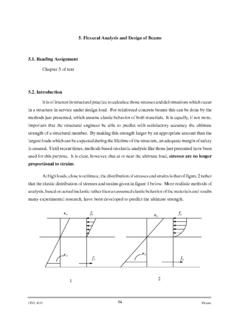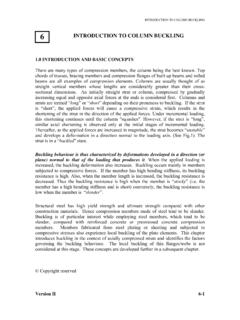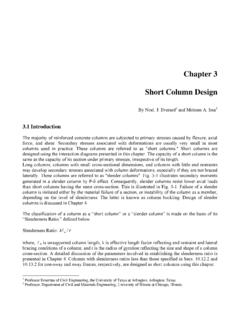Transcription of Chapter 1 Tension, Compression, and Shear
1 1 Chapter 1 Tension, Compression, and Shear Introduction Mechanics of Materials : to understand the behavior of solid bodies subjected to various types of loading This course have several names : "Strength of Materials", "Mechanics of Deformable Bodies" Two main aspects: 1. stress analysis : analysis of bodies under the action of external force, to determine the internal stress and their deformation 2. mechanical properties of materials : consideration of such things as material strength, stability, fatigue and brittle fracture etc. The principal objective of this analysis is to determine the stresses , strains, and displacements in structures and their components due to loads acting on them, we use the physical properties of the materials as well as numerous theoretical laws and concepts to analysis Theoretical analysis and experimental results have equally important roles in this study In the analyses, we will make logical derivations to obtain formulas and equations for predicting mechanical behavior, but we must recognize 2that this formula cannot be used in a realistic way unless certain properties of the materials are known, also.
2 Many practical problems of great important in engineering cannot be handled efficiently by theoretical means, experimental measurements becomes a necessity. In the study of this course, you will find that your efforts are divided naturally into two parts 1. understanding the logical development of the concepts 2. applying those concepts to practical situations Finally, sometime use the symbolic solution, it provides the opportunity to check the dimensions at any stage of the work, and the most important reason is to obtain a general formula that can be programmed on a computer Both systems of unit are used 1. International System of Units (SI unit) : basic units are kg, sec, m 2.
3 Customary System (USCS) : basic units are lb, sec, ft Relative Courses: Statics (Dynamics) --> Mechanics of Materials --> Advanced Mechanics of Materials --> Elasticity --> Plasticity, Viscoelasticity, Structural Stability, Plate and Shell, Experimental Stress analysis etc. Normal Stress and strain 3 Consider a prismatic bar, the axial forces produce a uniform stretching of the bar, it is called the bar is in tension mn : cross section z the longitudinal axis A : cross section area the intensity of the force (force per unit area) is called stress, assuming that the stress has uniform distribution, then P " = C force equilibrium A when the bar is stretched, the resulting stress are tensile stress, if the bar is compressed, the stress are compressive stress the stress " acts in the direction perpendicular to the cut surface, it is referred as normal stress, another type of stress is called Shear stress sign convention of the normal stresses are : tensile stress as positive and compressive stress as negative Unit of stress : SI unit.
4 N / m2 (Pa, Pascal), N / mm2 (MPa) 1 MPa = 106 Pa, 1 GPa = 109 Pa USCS : lb / in2 (psi), kip / in2 (ksi) 1 ksi = 103 psi 1 psi = 6,895 Pa 1 ksi = MPa 4 for a force P = 27 kN acts on a round bar with d = 50 mm, the stress is P P 27 kN " = C = CCC = CCCCCC = MPa A d2/4 (50 mm)2/4 The equation " = P / A to be valid only for the stress must be uniformly distributed over the cross section of the bar, this condition is realized if the axial force P acts through the centroid of the cross section the uniform stress condition exists throughout the length of the member except near the ends (end effect or Saint Venant's principle) if the load itself is distributed uniformly over the end, the stress at the end is the same as elsewhere, for the concentrated load acts at the end (over a small area)
5 , resulting in high localized stressed and nonuniform stress distribution the formula " = P / A may be used with good accuracy at any point that is at least a distant d away from the end, where d is the largest transverse dimension of the bar the formula " = P / A is the average normal stress when the stress distribution is nonuniform 5An axial load bar becoming longer when in tension and shorter when in compression the elongation is the cumulative of the stretching throughout the length L of the bar, then the elongation per unit length is called strain = C (normal strain : associated with normal stress) L tensile strain : positive compressive strain .
6 Negative strain is a dimensionless quantity, it is recorded in the form as mm/m, m/m, in/in L = 2 m, = mm x 10-3 m then = CCCCC = = mm/m 2 m = 700 x 10-6 = 700 m/m = Uniaxial Stress and strain for a prismatic bar, the loads act through the centroid of the cross sections, and the material be homogeneous, the resulting state of stress and strain is called uniaxial stress and strain 6 Line of Action of the Axial Forces for a Uniform Stress Distribution consider a prismatic bar of arbitrary cross-sectional shape subjected to axial forces P that produce uniformly distributed stresses ", let p1(x, y)
7 Represent the point in the cross section where the line of action of the forces intersects the cross section the moments of the force P are _ _ Mx = P y My = - P x for an element of area dA, the force acts on the element is " dA, and the moments of this elemental force about the x and y axes are " y dA and - " x dA, the total moments are obtained by integrating over the cross sectional area Mx = " y dA My = - " x dA _ _ then P y = " y dA P x = " x dA because the stress " is uniformly distributed, " = P / A, then _ _ y = y dA / A and x = x dA / A these equations are the same as the equations of the centroid of and area, thus we and concluded that.
8 In order to have uniform tension or compression in a prismatic bar, the axial force must act through the centroid of the cross-sectional area Example 1-1 for a hollow circular tube of aluminum supports a compressive load of 7240 kN, with d1 = 90 mm and d2 = 130 mm, its length is 1 m, the shortening of the tube is mm, determine the stress and strain A = C (d22 - d12) = C (1302 - 902) = 6,912 mm2 4 4 P 240,000 N " = C = CCCCC = MPa (comp.) A 6,912 mm2 the compressive strain is mm = C = CCCC = 550 x 10-6 = 550 m/m L 1,000 mm Example 1-2 a circular steel rod of length L and diameter d hangs and holds a weight W at its lower end (a) find "max of the rod, included its own weight (b) L = 40 m, d = 8 mm, W = kN, calculate "max (a) the maximum force Fmax occurs at the upper end Fmax = W + W0 = W + V = W + A L Fmax W + A L W "max = CC = CCCCC = C + L A A A (b)
9 The weight density of steel is 77 kN/m3, the maximum stress is 1,500 N "max = CCCCCC + (77 kN/m3) (40 m) (8 mm)2 / 4 = MPa + MPa = MPa 8 Mechanical Properties of Materials mechanical properties of materials used in engineering design are determined by tests of small specimen according standards ASTM : American Society for Testing of Materials JIS : Japanese Industrial Standards CNS : Chinese National Standards etc. the most common test is tension test for metals, to obtain the stress- strain diagram of materials (compression test are most used for rock and concrete) cylindrical specimen are used ASTM standard specimen for tension test (round bar) d = in ( mm) GL = in (50 mm) when the specimen is mounted on a testing system (MTS, Instron etc.)
10 , the load P and the elongation between GL are measured simultaneously static test : the load is applied very slowly dynamic test : load rate is very high 9 in the test " = P / A A : initial area of the cross section = / GL " : nominal stress (engineering stress) : nominal strain (engineering strain ) "t : true stress (use actual area of the bar) t : true strain (actual distance of GL is used) ( during test, A and GL may vary) specimens for compression test cubic : in (50 mm) on one side cylinder : d = 1 in (25 mm), L = 1 ~ 12 in (25 ~ 305 mm) concrete : d = 6 in (152 mm), L = 12 in (305 mm), 28 days old stress- strain diagram is characteristic of material for mild-steel (low carbon steel) A : proportional limit (210 ~ 350 MPa, 30 ~ 50 ksi) 10 B : yield stress (more than 550 MPa [80 ksi], depends on the carbon content) D : ultimate stress E : fracture OA : linear region BC : perfect plasticity CD : strain hardening DE : necking definitions of yield stress om : specified offset, commonly % om.












